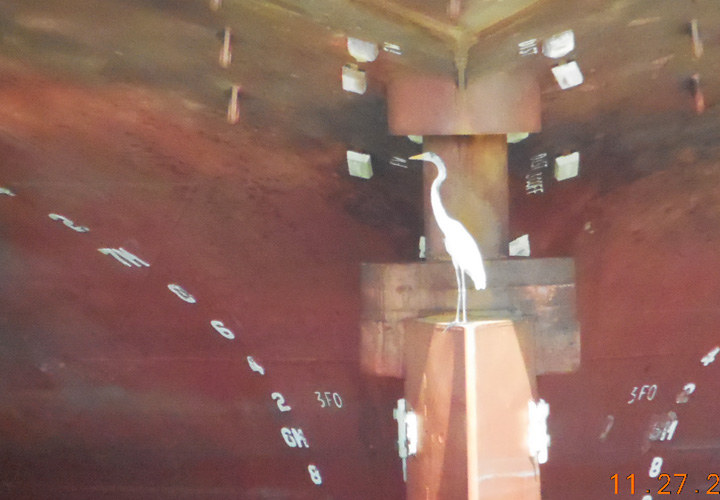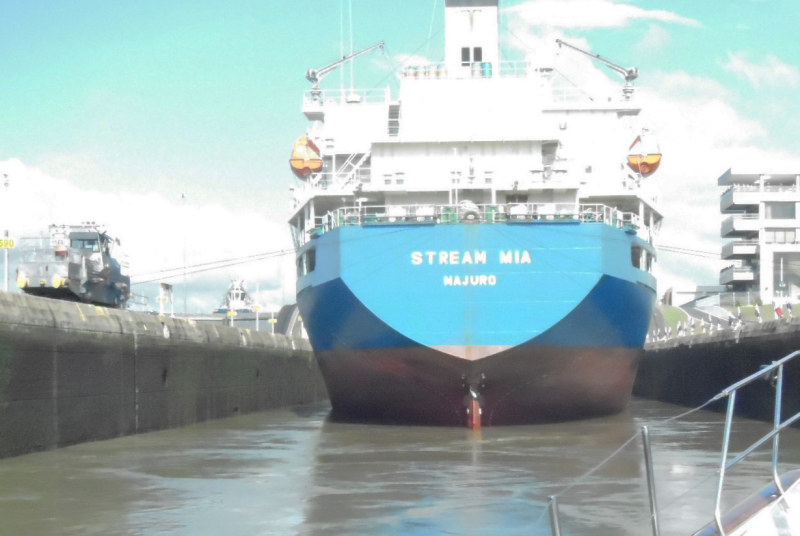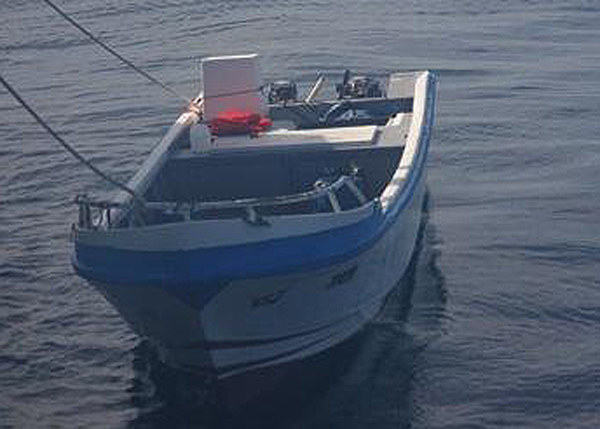
Winged Stowaway Photo Quiz

Today’s Photo Quiz comes from Dan Orlando. Can you tell us where is this heron standing?
All right, that’s pretty easy. It’s obviously perched atop the rudder of a large ship and surrounded by a bunch of zincs. The harder question is what country is the heron in. For the correct answer, check out the photo below.

Bismark Dinius’ Federal Lawsuit Settled
We are thrilled to report that a Federal lawsuit brought by sailor Bismarck Dinius, now 45, has been settled in his favor.
Regular readers will recall the bizarre case of sailor Lynn Thornton’s tragic death during a nighttime sail on Clear Lake on April 29, 2006. The boat she was riding in on that dark night, the O’Day 20 sloop Beat’s Workin’ II, was run over by a 385-hp speedboat driven by off-duty Lake County Sherriff’s Deputy Russell Perdock, who, witnesses claimed, was blasting across the lake at at least 40 knots — far too fast to see and react to any obstacles in his path.
But while Perdock was never charged in connection to the death, Dinius was, simply because he had his hand on the tiller of the nearly motionless sailboat at the time of the collision. Debate raged over whether or not the little sloop had its running lights on.
In the aftermath of the incident there was a long and thorny path toward any sort of justice, with Perdock losing his job (and his wife), several of his associates being terminated, apparently due to mishandling of the case, and Dinius eventually being acquitted of all charges in August, 2009.
But Dinius claims the protracted legal battle caused him to run up hundreds of thousands of dollars in legal fees, lose his job, and hyper-stress his family life.
According to the Lake County News, Dinius did not receive the $1 million he originally sought for punitive damages, violation of his civil rights, conspiracy and corruption, but the news organization notes that according to court records he did receive $210,000 from Perdock’s insurance carrier and Sacramento County, representing Lt. Charles Slabaugh, who assisted in the initial crash investigation.
Read the whole story and you’ll see that the mis-management of the Thornton death investigation led to all sorts of additional lay-offs or firings, additional lawsuits, and former District Attorney Jon E. Hopkins, who prosecuted Dinius while refusing to prosecute Perdock, not being re-elected. The whole affair was an extremely dark and embarrassing chapter in Lake County’s history. Even now, eight years later, the stigma of alleged corruption and wrong-doing remains — especially in the minds of Bay Area sailors.
More Brazen Smuggling Activity
On December 9 we reported that drug smugglers were taking increasingly brazen measures to import drugs to the US. Smuggler’s use of fast, open pangas (Mexican fishing boats) to motor up the West Coast is of great concern to California’s law enforcement authorities, and specifically the US Coast Guard, which is tasked with maritime surveillance and drug interdiction efforts.
More recently, on December 30, the San Diego-based U.S. Coast Guard Cutter Boutwell interdicted three suspected smugglers and seized 1,375 pounds of cocaine. The upshot of this activity is that mariners on the West Coast need to be extra careful and alert to these illicit activities.

In the past, smugglers’ activities centered closer to the Mexican border. Today, authorities are seeing a dramatic increase in the distances they travel — as far north as Big Sur for instance. In Santa Barbara, local ranchers have also been put on alert after smugglers landed on their remote beaches to unload large quantities of drugs.
If you happen to see any fast moving pangas, we’d strongly suggest you get out of their way and call the authorities as soon as safely possible. These smuggling activities often take place in broad daylight and you wouldn’t want to get caught-up in the melee.
The Dreadful Impoundment Fiasco In Mexico Endures
Despite the fervent wishes of almost everyone, most of the 338 foreign owned boats impounded in eight Mexican marinas as a result of AGACE actions in late November are still impounded. The sad fact is that most of these boats have been absolutely legal all along.
A couple of days ago, an insider in the marine industry in Mexico told us that our catamaran Profligate, which is on the list of impounded boats, was all good and didn’t have any problems with AGACE. So when the AGACE agents came to our marina yesterday, Dona de Mallorca asked them about the boat’s status. The pleasant AGACE agent looked into the files and said, "There are no problems with your boat."
"Great," said de Mallorca, "she’s free to go?"
"No," replied the AGACE agent, "she’s still impounded." He refused to say why or when she’ll be released. It’s our understanding that there are 47 other fully compliant boats in our marina in the same preposterous situation.
This is not good, Mexico. Not good at all.
Last night a boat owner with a boat impounded in a Baja marina called our office and asked what we thought of her and her husband leaving in the middle of the night on their boat and trying to flee back to freedom in the United States. She said that the impoundment of their boat had destroyed their cruising dream. They just wanted to get back to the States and sell their boat. She said there was another boat impounded in the same marina whose owner was also done with cruising before he started because of the ruthless actions of AGACE.
Our advice was to hang tight. Some impounded boats have been released, and it appears that many more will be soon. If someone gets caught trying to escape back to the United States — and we’re told that some have already been successful — you could find yourself in big trouble in a country where you don’t speak the language and the law is slow and murky. And if they did flee, they should probably be very hesitant to ever return to Mexico by boat — although it’s unlikely either of these owners will ever want to do that again.
As infuriating as this horrible episode has been, we’d also encourage these owners not to give up their cruising dreams just yet. The impounding of boats in Mexico has been the biggest national nautical brain fart that we can recall — and we’ve been publishing Latitude for 36 years. The self-destructive stupidity of the process is simply unprecedented.
It’s worth noting that three of the owner/mangers of the largest marinas in Mexico, two of whose marinas have been hit by AGACE, and one whose marina has not, said they believe it’s extremely unlikely there will be any similar raids until AGACE’s policies and procedures have been completely revamped. They all cite the same reason: the terrible damage to Mexico’s international reputation, particularly in the nautical tourism sector.
Just so everyone’s clear, we have no problem whatsoever with Mexico making sure that all boats have the necessary papers, that nobody is cheating on taxes, and that none of the boats are stolen. But currently there are severe impediments. One is that the laws are very unclear. For example, we asked the manager of one of the biggest port-of-entry marinas in Mexico whether zarpes from the US are required. He said he didn’t know that part of Mexican law. If he didn’t, how is a first-time visitor to Mexico supposed to know? And we bet 99% of people — including port captains — don’t know the law either. According to Neil Shroyer of Marina de La Paz, who tends to be an expert on such things, you either need a zarpe from the US — or a notarized letter stating, under penalty of perjury, that you came from the US. Not that we’ve ever been asked for either in all the years we’ve come to Mexico.
As much as we support Mexico’s goals of collecting taxes owed and apprehending stolen boats, the fact remains that these goals could have been quickly and easily achieved without the need for armed marines, the threats to marine businesses, boats being impounded, boat owners feeling compelled to flee the country, and tens of millions of dollars worth of negative publicity being rained down on Mexico. All it would have taken is for AGACE to announce that they were going to be at such and such a marina on such and such a day to make sure all boats were compliant by producing documents A through H, and that either the owner or his authorized representative needed to be on site to facilitate the process. And that when found to be in compliance, each boat would be given a sticker. It could have been so easy instead of so draconian.
One thing that’s become clear from our conversations with marina managers and owners, is that AGACE procedures and policies were different depending on where the AGACE agents came from and what marinas they were visiting. The marinas in Ensenada were visited by agents from Tijuana; the marinas at Los Cabos and San Carlos were visited by agents from Mexico City; the marinas in the Vallarta area were visited by agents from Zupopan/Guadalajara. In some places, agents never even bothered looking at or going on boats, they just wanted to check the paperwork. In other places, if you weren’t on your boat when they visited to show them around, your boat was as good as impounded.
It doesn’t help that Mexican law is so vague and so few people know or understand it. For example, a small but vocal group out of the Vallarta YC have made the claim that each boat owner is responsible for making sure that the office of the marina he’s in has a copy of all his paperwork. Leaving aside the question of how a boat owner can possibly be held responsible for the doings of the marina office, the manager of one of the biggest and glossiest marinas in Mexico emphatically insisted that his marina is under no legal obligation to have anyone’s documents. Mind you, he’s had very little problem with AGACE.
There has also been the question of whether not having a TIP is like a fix-it ticket in the United States. The owner of one marina says you have up to 10 days to get one after being found without one, and there is no fine. The manager of another marina says he can’t find that in law. But as a practical matter, the manager of yet a third marina said that boats that didn’t have TIPs in his marina were able to get them within 10 days, and they didn’t even end up on the impound list!
Mexican also has a nagging problem with requiring things that are impossible to do. For example, in the early days of getting a TIP online, the software program prompted the TIP applicant to identify what kind of boat they had. But the program only listed the names of a few powerboats. So applicants were left to either select the name of a boat they didn’t own, or not get a TIP. Such problems are rife throughout the Mexican bureaucracy. Here’s another example: We recently bought a car in Arizona and legally imported it into Mexico. The final two steps in the process are going to Tepic to get a document transferred from Nogales so we could pick up the license plates in Mezcales. Mexican law says we have seven days from the time we crossed the border to the time we put the plates on the car. Well, it’s been about three weeks now, and Nogales still hasn’t gotten the papers to Tepic — about 200 miles from where we are — so we can take them to Mezcales to get the plates. Whose fault is it that we are illegal and have to go around with 200 pesos notes in our pockets in case we’re stopped for ‘driving while gringo’?
Want more? Tax laws were dramatically changed in Mexico as of the first of the year, so the Mexican IRS has been holding meetings all over the country to explain them. Those who have been to the meetings say people left with more questions than they had before the meeting. The one thing they did come away with is that everybody who has any kind of business, or rents any rooms in their residence, has to have a Mexican IRS identity number and keep records of all debits and credits. The identity number can only be obtained on the Mexican IRS website. Alas, the website doesn’t work.
The truth is that Mexico is going to have to get its laws and bureaucracy together before it can emerge from the Third World. And until it gets those acts together, it is in its own best interest to refrain from coming down so hard on so many innocent people — particularly we nautical tourists, who are typically among the country’s best ambassadors. Mexico needs to release all compliant boats immediately, and then start the long road back to making amends with foreign boat owners and investors.
